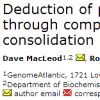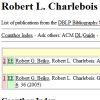| |
   
Dave MacLeod,
Robert L. Charlebois,
W. Ford Doolittle and
Eric Bapteste. Deduction of probable events of lateral gene transfer through comparison of phylogenetic trees by recursive consolidation and rearrangement. In BMCEB, Vol. 5(27), 2005.
Keywords: explicit network, from rooted trees, lateral gene transfer, phylogenetic network, phylogeny, Program HorizStory, reconstruction, software.
Note: http://dx.doi.org/10.1186/1471-2148-5-27.
Toggle abstract
"Background: When organismal phylogenies based on sequences of single marker genes are poorly resolved, a logical approach is to add more markers, on the assumption that weak but congruent phylogenetic signal will be reinforced in such multigene trees. Such approaches are valid only when the several markers indeed have identical phylogenies, an issue which many multigene methods (such as the use of concatenated gene sequences or the assembly of supertrees) do not directly address. Indeed, even when the true history is a mixture of vertical descent for some genes and lateral gene transfer (LGT) for others, such methods produce unique topologies. Results: We have developed software that aims to extract evidence for vertical and lateral inheritance from a set of gene trees compared against an arbitrary reference tree. This evidence is then displayed as a synthesis showing support over the tree for vertical inheritance, overlaid with explicit lateral gene transfer (LGT) events inferred to have occurred over the history of the tree. Like splits-tree methods, one can thus identify nodes at which conflict occurs. Additionally one can make reasonable inferences about vertical and lateral signal, assigning putative donors and recipients. Conclusion: A tool such as ours can serve to explore the reticulated dimensionality of molecular evolution, by dissecting vertical and lateral inheritance at high resolution. By this, we mean that individual nodes can be examined not only for congruence, but also for coherence in light of LGT. We assert that our tools will facilitate the comparison of phylogenetic trees, and the interpretation of conflicting data. © 2005 MacLeod et al; licensee BioMed Central Ltd."
|
|
| |
 
Robert G. Beiko and
Nicholas Hamilton. Phylogenetic identification of lateral genetic transfer events. In BMCEB, Vol. 6(15), 2006.
Keywords: evaluation, from rooted trees, from unrooted trees, lateral gene transfer, Program EEEP, Program HorizStory, Program LatTrans, reconstruction, software, SPR distance.
Note: http://dx.doi.org/10.1186/1471-2148-6-15.
Toggle abstract
"Background: Lateral genetic transfer can lead to disagreements among phylogenetic trees comprising sequences from the same set of taxa. Where topological discordance is thought to have arisen through genetic transfer events, tree comparisons can be used to identify the lineages that may have shared genetic information. An 'edit path' of one or more transfer events can be represented with a series of subtree prune and regraft (SPR) operations, but finding the optimal such set of operations is NP-hard for comparisons between rooted trees, and may be so for unrooted trees as well. Results: Efficient Evaluation of Edit Paths (EEEP) is a new tree comparison algorithm that uses evolutionarily reasonable constraints to identify and eliminate many unproductive search avenues, reducing the time required to solve many edit path problems. The performance of EEEP compares favourably to that of other algorithms when applied to strictly bifurcating trees with specified numbers of SPR operations. We also used EEEP to recover edit paths from over 19 000 unrooted, incompletely resolved protein trees containing up to 144 taxa as part of a large phylogenomic study. While inferred protein trees were far more similar to a reference supertree than random trees were to each other, the phylogenetic distance spanned by random versus inferred transfer events was similar, suggesting that real transfer events occur most frequently between closely related organisms, but can span large phylogenetic distances as well. While most of the protein trees examined here were very similar to the reference supertree, requiring zero or one edit operations for reconciliation, some trees implied up to 40 transfer events within a single orthologous set of proteins. Conclusion: Since sequence trees typically have no implied root and may contain unresolved or multifurcating nodes, the strategy implemented in EEEP is the most appropriate for phylogenomic analyses. The high degree of consistency among inferred protein trees shows that vertical inheritance is the dominant pattern of evolution, at least for the set of organisms considered here. However, the edit paths inferred using EEEP suggest an important role for genetic transfer in the evolution of microbial genomes as well. © 2006Beiko and Hamilton; licensee BioMed Central Ltd."
|
|
|
|